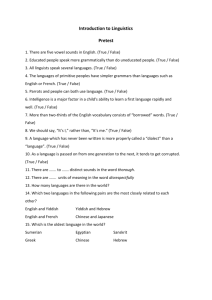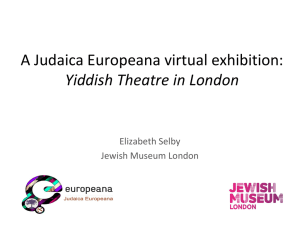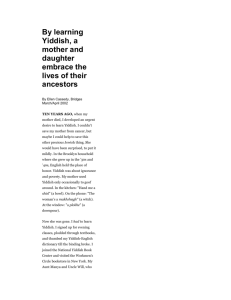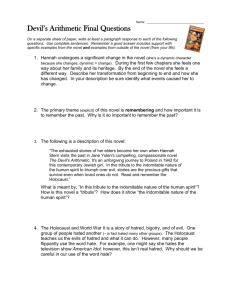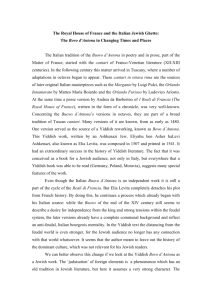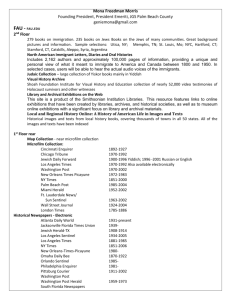Introduction to Yiddish Language and Culture
advertisement
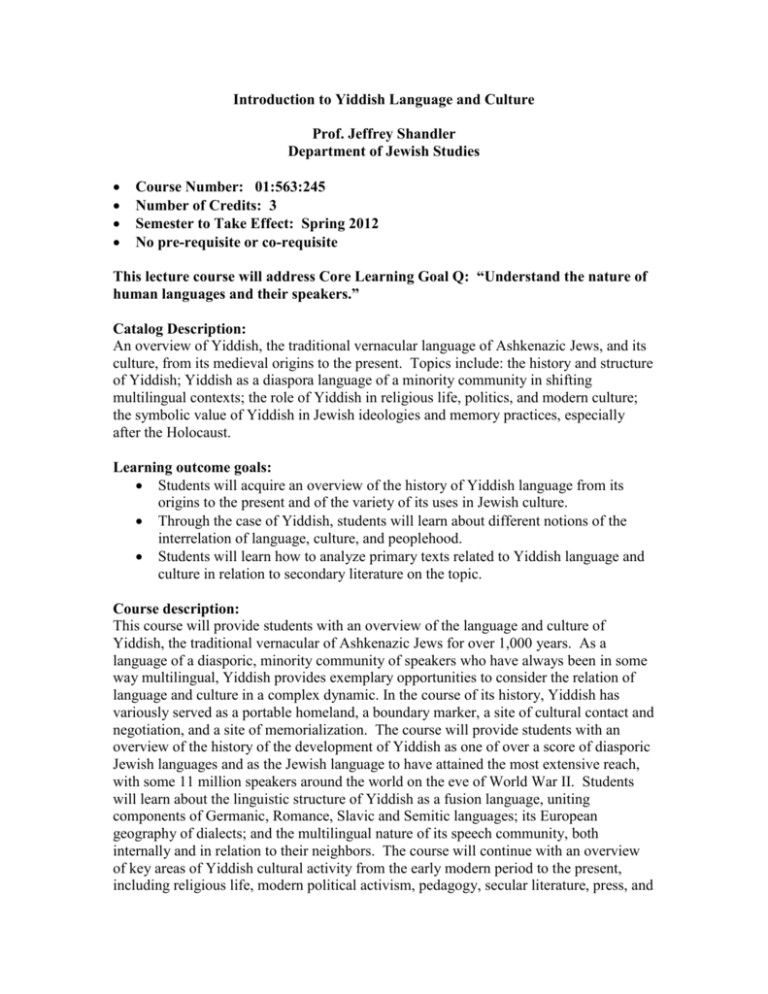
Introduction to Yiddish Language and Culture Prof. Jeffrey Shandler Department of Jewish Studies Course Number: 01:563:245 Number of Credits: 3 Semester to Take Effect: Spring 2012 No pre-requisite or co-requisite This lecture course will address Core Learning Goal Q: “Understand the nature of human languages and their speakers.” Catalog Description: An overview of Yiddish, the traditional vernacular language of Ashkenazic Jews, and its culture, from its medieval origins to the present. Topics include: the history and structure of Yiddish; Yiddish as a diaspora language of a minority community in shifting multilingual contexts; the role of Yiddish in religious life, politics, and modern culture; the symbolic value of Yiddish in Jewish ideologies and memory practices, especially after the Holocaust. Learning outcome goals: Students will acquire an overview of the history of Yiddish language from its origins to the present and of the variety of its uses in Jewish culture. Through the case of Yiddish, students will learn about different notions of the interrelation of language, culture, and peoplehood. Students will learn how to analyze primary texts related to Yiddish language and culture in relation to secondary literature on the topic. Course description: This course will provide students with an overview of the language and culture of Yiddish, the traditional vernacular of Ashkenazic Jews for over 1,000 years. As a language of a diasporic, minority community of speakers who have always been in some way multilingual, Yiddish provides exemplary opportunities to consider the relation of language and culture in a complex dynamic. In the course of its history, Yiddish has variously served as a portable homeland, a boundary marker, a site of cultural contact and negotiation, and a site of memorialization. The course will provide students with an overview of the history of the development of Yiddish as one of over a score of diasporic Jewish languages and as the Jewish language to have attained the most extensive reach, with some 11 million speakers around the world on the eve of World War II. Students will learn about the linguistic structure of Yiddish as a fusion language, uniting components of Germanic, Romance, Slavic and Semitic languages; its European geography of dialects; and the multilingual nature of its speech community, both internally and in relation to their neighbors. The course will continue with an overview of key areas of Yiddish cultural activity from the early modern period to the present, including religious life, modern political activism, pedagogy, secular literature, press, and the performing and visual arts. Special attention will be paid to ideological investments in language use as they relate to other aspects of Jewish life. Finally, the course will consider the role of Yiddish both during the Holocaust—when half of the speech community was murdered and its European cultural center destroyed—and afterwards, as both Jews and others forge new relations with the language, which are often centered less on its vernacularity than on its symbolic value. Comparisons will be made during the course to other languages with similar valences, including other “endangered heritage languages,” such as Irish, Occitan, and American Indian languages. Students will read secondary material providing background on Yiddish language and culture, as well as primary texts that exemplify key moments in Yiddish culture. All course readings and materials will be in English. No prior knowledge of linguistics, of Yiddish or any other language, or of Jewish history or religion is required. Writing requirements: Response papers (choice of 5 out of 9 assignments) Field assignment (analysis of a Yiddish performance, either on campus or in NYC) Final examination (identifications and essay questions) Assessment of core learning goal: Learning goal Q will be assessed with one or more essay questions, as part of the course final examination, in which students will be asked to discuss what the study of Yiddish language and culture reveals about the nature of language and its speakers. Special attention will be paid to assessing students’ grasp of the interrelation of instrumental engagements with the language vs. symbolic engagements and to shifting notions of the interrelation of Yiddish language, culture, and its speech community. The course will use a rubric modeled on the CRC’s generic Core rubrics and the CRC’s reporting form. Provisional course schedule: Week 1. Introduction: Historical background of Yiddish Benjamin Harshav, The Meaning of Yiddish (Berkeley, 1990), selection. 2. The linguistic foundations of Yiddish Max Weinreich, History of the Yiddish Language, trans. Shlomo Noble with the assistance of Joshua A. Fishman (Chicago, 1980), selections. Uriel Weinreich, “Mapping a Culture,” Columbia University Forum 6:3 (1963): 17-21. 3. Yiddish in early modern Ashkenazic Jewish life Chava Turniansky, “On Old-Yiddish Biblical Epics,” in International Folklore Review 8 (1991): 26-33. Robert G. Warnock, “Some Aspects of Reading Old Yiddish Literary Texts,” in Yiddish 4:3 (1981): 20-32. Chava Weissler, “Prayers in Yiddish and the Religious World of Ashkenazic Women,” in Baskin, Jewish Women in Historical Perspective (Detroit, 1991), 159-181. Joseph Schultz, “The ‘Ze'enah u-Re'enah’: Torah for the Folk,” Judaism 36:1 (1987); 84-96 Primary texts: examples of tkhines, excerpts from Tsenerene, Mayse-bukh 4. Responses to modernity: Hasidic Yiddish and Maskilic Yiddish Howard Schwartz, “Rabbi Nachman of Bratslav, Forerunner of Modern Jewish Literature,” Judaism 31:2 (1982): 211-224. David Roskies, “The Medium and Message of the Maskilic [Yiddish] Chapbook,” Jewish Social Studies 41:3/4 (1979): 275-290. Iris Parush, Reading Jewish Women: Marginality and Modernization in Nineteenth-century Eastern European Jewish Society (Waltham, 2004), selection. Primary texts: Hasidic tales, fiction by I.M. Dik 5. Yiddish and modern secular culture Dan Miron, “The discovery of Mendele Moykher-Sforim and the Beginnings of Modern Yiddish Literature,” YIVO Annual of Jewish Social Science 15 (1974): 66-81. Sarah Abrevaya Stein, Making Jews Modern: The Yiddish and Ladino Press in the Russian and Ottoman Empires (Bloomington, 2004), selection. Primary texts: Excerpts from memoirs by Abramovitch, Kotik 6. Yiddish and the political culture in Eastern Europe before World War I Barry Trachtenberg, “Ber Borochov’s ‘The Tasks of Yiddish Philology,’” in Science in Context 20:2 (2007): 341-379. Yael Chaver, “From Mother-tongue to the Voice within: The Marginalization of Yiddish in Zionist Palestine,” in The Life and Times of Yiddish (2000) 145-176. Primary texts: Writings of Zhitlowski, Dubnov 7-8. Yiddish in Interwar Poland David Fishman, “The Bund and Modern Yiddish Culture,” in The Emergence of Modern Jewish Politics, (2003), 107-119. Cecile Kuznitz, “On the Jewish Street: Yiddish Culture and the Urban Landscape in Interwar Vilna,” in Studies in Jewish Civilization 9 (1998): 65-92. Image Before My Eyes (film) Primary texts: Dawidowicz memoir, YIVO youth autobiography 9. Soviet Yiddish culture Rachel Erlich, “Politics and Linguistics in the Standardization of Soviet Yiddish,” in Soviet Jewish Affairs 3 (1973): 71-79. David Shneer, “Making Yiddish Modern: The Creation of a Yiddish-language Establishment in the Soviet Union,” East European Jewish Affairs 30:2 (2000): 77-98. Ruth Apter-Gabriel, ed., Tradition and Revolution: The Jewish Renaissance in Russian Avant-Garde Art 1912-1928 (Jerusalem, 1987), pp. 125-142. Robert Weinberg, Stalin’s Forgotten Zion: Birobidzhan and the Making of a Soviet Jewish Homeland (Berkeley, 1998), selection. Primary texts: Beregovski on Jewish folk music, Marc Chagall memoir 10-12. Immigrant Yiddish culture in America Nina Warnke, “Theater as Educational Institution: Jewish Immigrant Intellectuals and Yiddish Theater Reform,” in The Art of Being Jewish in Modern Times, (2008) 23-41. Sandra Parker, “An Educational Assessment of the Yiddish Secular School Movements in the U.S.,” in Joshua A. Fishman, ed., Never Say Die! A Thousand Years of Yiddish in Jewish Life and Letters (The Hague: Mouton, 1981), 495-511. Tony Michels, “’Speaking to Moyshe’: The Early Socialist Yiddish Press and Its Readers,” Jewish History 14:1 (2000): 51-82. Ari Kelman, “The Acoustic Culture of Yiddish,” Shofar 25:1 (2006): 127-151. J. Hoberman, Bridge of Light: Yiddish Film Between Two Worlds (New York, 1991), selection. Free Voice of Labor (film) Primary texts: Bintl Briv selections; Inzikhist manifesto 13. Yiddish and the Holocaust Anita Norich, Discovering Exile: Yiddish and Jewish American Culture During the Holocaust (Stanford, 2007), selection. Miriam Isaacs, “Yiddish in the Aftermath,” in Jewishness: Expression, Identity, and Representation, ed. Simon Bronner (Oxford, 2008), 85-104. Primary texts: excerpts from memorial books 14. Yiddish after World War II Jeffrey Shandler, Adventures in Yiddishland: Postvernacular Language and Culture (Berkeley, 2005), selection. Ayala Fader, Mitzvah Girls: Bringing up the next generation of Hasidic Jews in Brooklyn (Princeton, 2009), selection. Primary texts: poems by Irena Klepfisz
